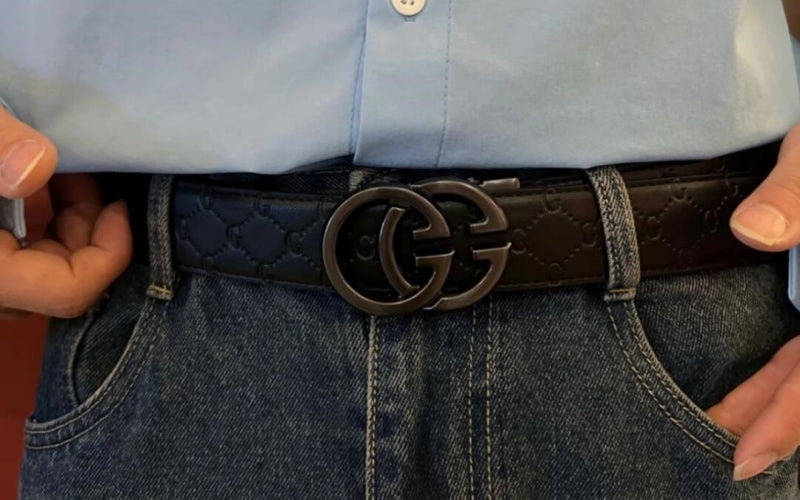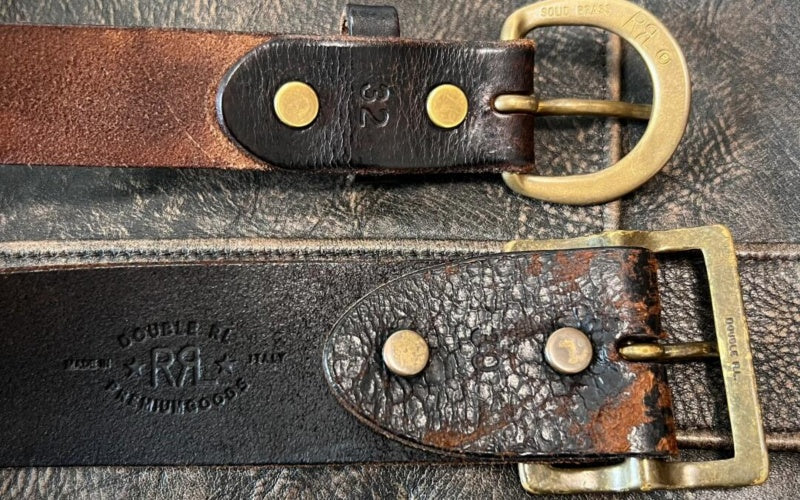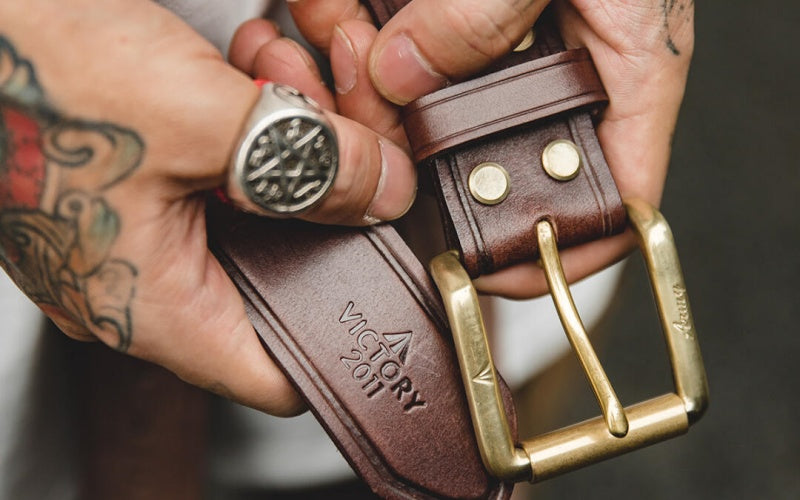
When Did Men Start Wearing Belts? (Way Before They Could Say ‘Dad Bod’)
Let’s take a wild guess: You’re reading this while wearing a belt. Maybe it’s holding up your jeans, cinching a suit, or just… there, like a silent hero keeping your pants from committing a felony.
But have you ever wondered when men started looping strips of leather (or fabric, or blinged-out metal) around their waists? Was there a prehistoric Steve Jobs of belts? Did cavemen trade mammoth tusks for the first buckle prototypes?
The answer is juicier than you think. Belts have been through more drama than a reality TV show—wars, status symbols, fashion revolutions, and even a centuries-long feud with suspenders.
In this deep dive, we’ll unravel the twisted history of men’s belts, from Stone Age tool-belts to Beltley’s modern luxe designs. Buckle up—it’s a wild ride.
 Love this belt? Click the pic to see more just like it.
Love this belt? Click the pic to see more just like it.
The Short Answer: Men Have Worn Belts Since 3,000 BCE (But Let’s Get Specific)
The earliest known belts date back to the Bronze Age (3,000–1,000 BCE), used to carry tools and weapons. But belts as fashion? That took a few millennia (and some royal tantrums).
1. The Stone Age: Belts as Survival Gear
What They Wore: Animal hides tied with vines or strips of leather.
Purpose: Holding tools, weapons, and the occasional snack (raw mammoth, anyone?).
Style Points: Zero. Function over flair was the motto.
Fun Fact: The oldest surviving belt is the 3,300-year-old Bronze Age belt found in Denmark, adorned with spiral designs. It’s like the ancient equivalent of a “Live, Laugh, Loot” tattoo.
 Love this belt? Click the pic to see more just like it.
Love this belt? Click the pic to see more just like it.
2. Ancient Civilizations: Belts as Status Symbols
Egyptians (3,000 BCE):
-
Who Wore Them: Pharaohs and warriors.
-
Design: Gold and jewel-encrusted belts to flex wealth and divine power.
-
Iconic Moment: King Tut’s belt featured a golden clasp shaped like a scarab beetle. Talk about bling.
Greeks (800–146 BCE):
-
Who Wore Them: Mostly soldiers. Civilians? They preferred draped tunics sans belts.
-
Design: Leather straps called zoster to hold armor.
Romans (27 BCE–476 CE):
-
Who Wore Them: Soldiers (cingulum militare) and senators.
-
Design: Military belts with dangling straps (baltea) to intimidate enemies (and show rank).
-
Legacy: The phrase “to tighten one’s belt” comes from Roman soldiers adjusting their gear pre-battle.
 Love this belt? Click the pic to see more just like it.
Love this belt? Click the pic to see more just like it.
3. Medieval Times (5th–15th Century): Belts as Power Moves
Knights & Nobles:
-
Purpose: Holding swords, armor, and giant keys to castles.
-
Design: Wide leather belts with ornate buckles. Some weighed up to 10 pounds!
-
Status Symbol: Silver or gold belts = “I own land.” Rope belts = “I till land.”
Monks & Clergy:
-
Purpose: Symbolizing chastity and humility.
-
Design: Simple rope belts (cincture) with three knots for vows.
Pro Tip: Want to start a medieval feud? Steal a lord’s belt. It was like swiping his Rolex.
 Love this belt? Click the pic to see more just like it.
Love this belt? Click the pic to see more just like it.
4. Renaissance (14th–17th Century): Belts Get a Makeover
The Fashion Revolution:
-
Tight Clothes: Doublets and hose required belts for structure.
-
Design: Embroidered silk belts with fancy buckles.
Pirate Core (16th–17th Century):
-
Who Wore Them: Swashbucklers like Blackbeard.
-
Purpose: Holding pistols, swords, and treasure maps.
-
Style: Wide leather belts slung low on hips. The original “dad jeans” vibe.
5. 18th–19th Century: Belts vs. Suspenders (The Great Waist War)
Suspenders Dominate:
-
Why: High-waisted pants + tailcoats made belts impractical.
-
Fans: Victorian dandies, Abraham Lincoln.
Belts Strike Back (Late 1800s):
-
Why: Military uniforms (like the U.S. Cavalry) adopted belts for durability.
-
Iconic Belt: The Sam Browne belt, designed by a British officer who lost an arm and needed a way to carry his sword.
Pro Tip: Suspenders still held sway until WWII, when belts became standard-issue for soldiers.
Love this belt? Click the pic to see more just like it.
6. 20th Century: Belts Take Over the World
1920s–1930s:
-
Jeans Revolution: Levi’s introduced belt loops in 1922. Suspenders? Officially uncool.
-
Hollywood Influence: Clark Gable’s belt-clad look in It Happened One Night (1934) made belts a must-have.
1950s–1960s:
-
Rebel Belts: Greasers rocked oversized buckles (think: Elvis’s gold belt).
-
Military Influence: WWII soldiers brought utilitarian belts home, normalizing them for civilians.
1980s–1990s:
-
Logomania: Designer belts (Gucci, Hermès) became status symbols.
-
Skater Culture: Studded belts and chain wallets = suburban rebellion.
Fun Fact: The 90s “belt-over-flannel” trend was the original “I’m not like other guys” move.
 Love this belt? Click the pic to see more just like it.
Love this belt? Click the pic to see more just like it.
7. 21st Century: Belts as Art
-
Luxury Craftsmanship: Brands like Beltley blend traditional techniques with modern design.
-
Tech Integration: Ratchet belts, eco-friendly materials.
-
Gender Fluidity: Belts are now unisex, from androgynous styles to statement buckles.
 Love this belt? Click the pic to see more just like it.
Love this belt? Click the pic to see more just like it.
Why Beltley’s Belts Honor This Legacy
Today’s belts are more than accessories—they’re heirs to 5,000 years of innovation. Beltley pays homage to this history with:
-
Full-Grain Leather: The same durable material used by Bronze Age warriors (minus the mammoth smell).
-
Timeless Design: Clean lines inspired by medieval craftsmanship and modern minimalism.
-
Solid Brass Buckles: Built to last longer than your Wi-Fi password.
Our belts aren’t just functional; they’re wearable history.
 Love this belt? Click the pic to see more just like it.
Love this belt? Click the pic to see more just like it.
FAQs: Your Belt History Questions, Answered
Q: What’s the oldest surviving belt?
A: The 3,300-year-old Trundholm Sun Chariot Belt from Denmark.
Q: Did Vikings wear belts?
A: Yes! Leather belts with intricate buckles to hold weapons and tools.
Q: Why did belts replace suspenders?
A: Belt loops on jeans (1920s) + military practicality made them mainstream.
Q: When did belts become fashion statements?
A: Renaissance nobility started it, but 1980s designers turned them into bling.
Q: Are Beltley’s belts historically accurate?
A: We skip the 10-pound buckles, but our craftsmanship nods to centuries of tradition.
From Bronze Age to Dad Bod: The Belt’s Journey Continues
Belts have evolved from survival gear to status symbols to everyday essentials. They’ve survived wars, fashion fads, and the rise of elastic waistbands.
And while we might not need them to carry swords anymore (unless you’re into LARPing), they remain a testament to human ingenuity and style.
Ready to Wear History?
Explore Beltley’s Collection—where ancient craftsmanship meets modern luxury, and every belt tells a story.
P.S. If your current belt has less heritage than a gas station sandwich, maybe it’s time for an upgrade. Your ancestors would approve. 😎


